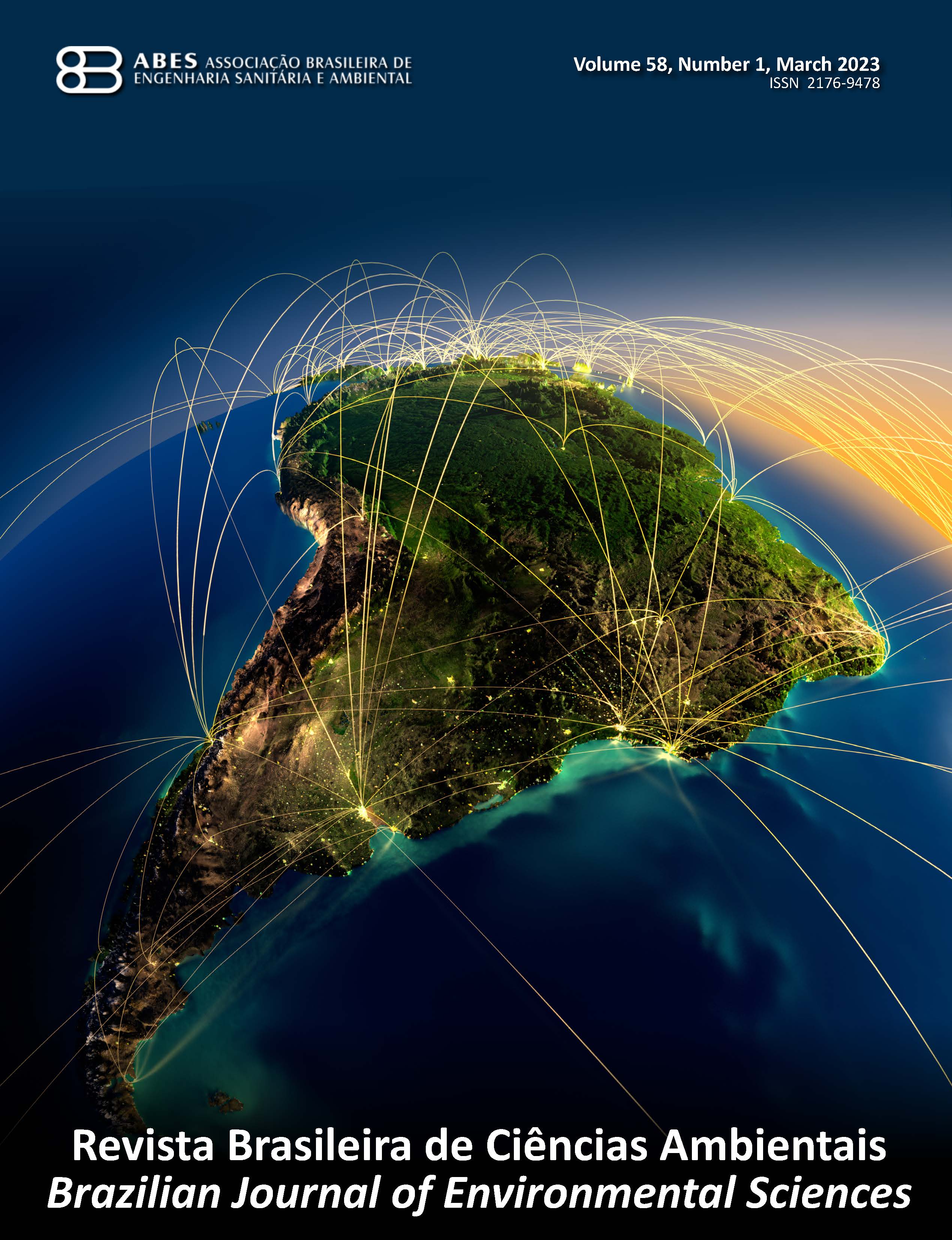Analysis of a photovoltaic-thermal with heat pump system for engine heating in thermal power plants
DOI:
https://doi.org/10.5327/Z2176-94782218Palavras-chave:
protótipo em escala de bancada; dinâmica de fluidos computacional; eficiência térmica; ampliação de escala; energia solar; aplicações industriaisResumo
Este estudo realizou uma análise computacional e validação experimental de um sistema fotovoltaico-térmico (PVT, photovoltaic-thermal) híbrido combinado com uma bomba de calor para aquecimento de motores em usinas termelétricas. Utilizando o software Ansys Fluent para simulações de dinâmica de fluidos computacional, a pesquisa examinou o desempenho térmico e a eficiência do sistema PVT sob condições reais de operação. As simulações confirmaram que o sistema PVT pode alcançar alta eficiência térmica, especialmente durante períodos de máxima radiação solar. O modelo de malha utilizado nas simulações foi composto por 6.589.347 elementos, refinado para capturar os detalhes do fluxo de fluido e transferência de calor. Os resultados indicaram que a temperatura máxima da água na saída atingiu 315 K, enquanto os testes experimentais mostraram uma temperatura máxima de 328,15 K. A eficiência térmica máxima observada foi de 73% ao meio-dia. O estudo também demonstrou a viabilidade de ampliar o sistema de um protótipo em escala de bancada para aplicações industriais. Ao empregar a aproximação de Boussinesq e manter os números adimensionais de Reynolds, Nusselt, Prandtl, Grashof e Rayleigh, as simulações em escala reduzida mostraram-se confiáveis e comparáveis a sistemas em escala real. A integração do sistema PVT com uma bomba de calor demonstrou ser eficaz na redução do consumo de combustíveis fósseis, permitindo a geração simultânea de eletricidade e calor, melhorando a eficiência energética e reduzindo os custos operacionais em ambientes industriais. O sistema PVT enfrenta limitações climáticas, altos custos e desafios de integração industrial. O presente estudo reconhece os desafios para a adoção generalizada de sistemas PVT e sugere pesquisas futuras para otimizar esses sistemas em diversos contextos climáticos e geográficos.
Downloads
Referências
Alghamdi, H.; Maduabuchi, C.; Okoli, K.; Alobaid, M.S.; Alghassab, M.; Alsafran, A.S.; Makk, E.; Alkhedher, M., 2024. Latest advancements in solar photovoltaic-thermoelectric conversion technologies: thermal energy storage using phase change materials, machine learning, and 4E analyses. International Journal of Energy Research, Article ID 1050785, 29 p. https://doi.org/10.1155/2024/1050785.
Céspedes, S.; Molina, A.; Lerner, B.; Pérez, M.S.; Franco, C.A.; Cortés, F.B., 2021. A selection flowchart for micromodel experiments based on computational fluid dynamic simulations of surfactant flooding in enhanced oil recovery. Processes, v. 9 (11), 1887. https://doi.org/10.3390/pr9111887.
Dahham, R.Y.; Wei, H.; Pan, J., 2022. Improving thermal efficiency of internal combustion engines: recent progress and remaining challenges. Energies, v. 15 (17), 6222. https://doi.org/10.3390/en15176222.
Einarsrud, K.E.; Loomba, V.; Olsen, J.E., 2023. Special issue: applied computational fluid dynamics (CFD). Processes, v. 11 (2), 461. https://doi.org/10.3390/pr11020461.
Gaur, A.S.; Fitiwi, D.Z.; Curtis, J., 2022. Heat pumps and our low-carbon future: A comprehensive review. Energy Research & Social Science, v. 71, 101764. https://doi.org/10.1016/j.erss.2020.101764.
Ghamari, M.; Sundaram, S., 2024. Solar wall technology and its impact on building performance. Energies, v. 17 (5), 1075. https://doi.org/10.3390/en17051075.
Ghanim, M.S.; Farhan, A.A., 2022. Performance evaluation of the photovoltaic thermal system with a fin array and surface zigzag layout. International Journal of Low-Carbon Technologies, v. 17, 1166-1176. https://doi.org/10.1093/ijlct/ctac092.
Gil, J.D.; Ramos-Teodoro, J.; Romero-Ramos, J.A.; Escobar, R.; Cardemil, J.M.; Giagnocavo, C.; Pérez, M., 2021. Demand-side optimal sizing of a solar energy–biomass hybrid system for isolated greenhouse environments: methodology and application example. Energies, v. 14 (13), 3724. https://doi.org/10.3390/en14133724.
Guo, Z.; Shan, J.; Li, J.; Levtsev, A., 2021. Test of the layout of the correction circuit with a plate heat exchanger. Bulletin of Science and Practice, v. 7 (1), 279-287. https://doi.org/10.33619/2414-2948/62/28.
Hasan, M.M.; Hossain, S.; Mofijur, M.; Kabir, Z.; Badruddin, I.A.; Yunus Khan, T.M.; Jassim, E., 2023. Harnessing solar power: a review of photovoltaic innovations, solar thermal systems, and the dawn of energy storage solutions. Energies, v. 16 (18), 6456. https://doi.org/10.3390/en16186456.
Herrando, M.; Markides, C.N.; Hellgardt, K., 2014. A UK based assessment of hybrid PV and solar thermal systems for domestic heating and power: System performance. Applied Energy, v. 122, 288-309. https://doi.org/10.1016/j.apenergy.2014.01.061.
Khan, M.A.I.; Khan. M.I.; Kazim, A.H.; Shabir, A.; Riaz, F.; Mustafa, N.; Javed, H.; Raza, A.; Hussain, M.; Salman, C.A., 2021. An experimental and comparative performance evaluation of a hybrid photovoltaic thermoelectric system. Frontiers in Energy Research, v. 9, 722514. https://doi.org/10.3389/fenrg.2021.722514.
Krishnani, M.; Basu, D.N., 2016. On the validity of Boussinesq approximation in transient simulation of single phase natural circulation loops. International Journal of Thermal Sciences, v. 105, 224-232. https://doi.org/10.1016/j.ijthermalsci.2016.03.004.
Lorenzo, C.; Narvarte, L., 2019. Performance indicators of photovoltaic heat-pumps. Heliyon, v. 5 (10), e02691. https://doi.org/10.1016/j.heliyon.2019.e02691.
Mayeli, P.; Sheard, G.J., 2021. Buoyancy-driven flows beyond the Boussinesq approximation: A brief review. International Communications in Heat and Mass Transfer, v. 125, 105316. https://doi.org/10.1016/j.icheatmasstransfer.2021.105316.
Nikitin, L.V.; Ryzhak, E.I., 1981. Accuracy of the Boussinesq approximation for an incompressible fluid. Fluid Dyn, v. 16, 174-180. https://doi.org/10.1007/BF01090344.
Pauly, L.; Rekhab, L.; Vazhappillya, C.V.; Ra, M.C., 2026. Numerical simulation for solar hybrid photovoltaic thermal air collector. Procedia Technology, v. 24, 513-522. https://doi.org/10.1016/j.protcy.2016.05.088.
Reichl, C.; Both, S.; Mascherbauer, P.; Emhofer, J., 2022. Comparison of two CFD approaches using constant and temperature dependent heat capacities during the phase transition in PCMs with experimental and analytical results. Processes, v. 10, 302. https://doi.org/10.3390/pr10020302.
Rosli, M.A.M.; Latif, I.A.F.; Nawam, M.Z.; Saadun, M.N.A.; Jarimi, H.; Sharif, M.K.A.; Ali, S., 2021. A simulation study on temperature uniformity of photovoltaic thermal using computational fluid dynamics. Journal of Advanced Research in Fluid Mechanics and Thermal Sciences, v. 82 (1), 21-38. https://doi.org/10.37934/arfmts.82.1.2138.
Saini, P.; Ghasemi, M.; Arpagaus, C.; Bless, F.; Bertsch, S.; Zhang, X., 2023. Techno-economic comparative analysis of solar thermal collectors and high-temperature heat pumps for industrial steam generation. Energy Conversion and Management, v. 277, 116623. https://doi.org/10.1016/j.enconman.2022.116623.
Salameh, T.; Tawalbeh, M.; Juaidi, A.; Abdallah, R., 2021. A novel three-dimensional numerical model for PV/T water system in hot climate region. Renewable Energy, v. 164, 1320-1333. https://doi.org/10.1016/j.renene.2020.10.137.
Saurabh, A.; Atheaya, D.; Kumar, A., 2019. Computational fluid dynamics (CFD) modelling of hybrid photovoltaic thermal system. Vibroengineering Procedia, v. 29 (3), 243-248. https://doi.org/10.21595/vp.2019.21098.
Sornek, K.; Goryl, W.; Figaj, R.; Dabrowska, G.; Brezdeń, J., 2022. Development and tests of the water cooling system dedicated to photovoltaic panels. Energies, v. 15, 5884. https://doi.org/10.3390/en15165884.
Starowicz, A.; Rusanowska, P.; Zieliński, M., 2023. Photovoltaic cell – the history of invention – review. Polityka Energetyczna – Energy Policy Journal, v. 26 (1), 169-180. https://doi.org/10.33223/epj/161290.
Yan, B.; Wu, Q.; Chi, X.; Wu, C.; Luo, P.; Luo, Y.; Zeng, P., 2022. Numerical and experimental investigation of photovoltaic/thermal systems: parameter analysis and determination of optimum flow. Sustainability, v. 14, 10156. https://doi.org/10.3390/su141610156.
Yüzer, E.O.; Bozkurt, A., 2023. Evaluation of photovoltaic panel power generation based on instant solar radiation and meteorological parameters. Afyon Kocatepe University Journal of Science and Engineering, v. 23, 1171-1179. https://doi.org/10.35414/akufemubid.1300086.
Zisopoulos, G.; Nesiadis, A.; Atsonios, K.; Nikolopoulos, N.; Stitou, D.; & Coca-Ortegón, A., 2021. Conceptual design and dynamic simulation of an integrated solar driven thermal system with thermochemical energy storage for heating and cooling. Journal of Energy Storage, v. 41, 102870. https://doi.org/10.1016/j.est.2021.102870.
Downloads
Publicado
Como Citar
Edição
Seção
Licença
Copyright (c) 2025 Revista Brasileira de Ciências Ambientais

Este trabalho está licenciado sob uma licença Creative Commons Attribution 4.0 International License.

























